
William Diller Matthew FRS was a vertebrate paleontologist who worked primarily on mammal fossils, although he also published a few early papers on mineralogy, petrological geology, one on botany, one on trilobites, and he described Tetraceratops insignis, which was much later suggested to be the oldest known therapsid.
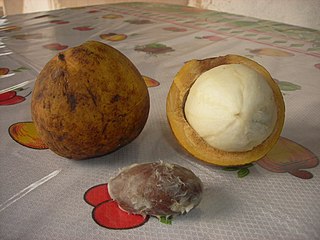
Platonia insignis, the sole species of the genus Platonia, is a tree of the family Clusiaceae native to South America in the humid forests of Brazil, Paraguay, parts of Colombia and northeast to Guyana; especially in Amazon Rainforest. Common names include bacuri, maniballi, naranjillo and bacurizeiro.
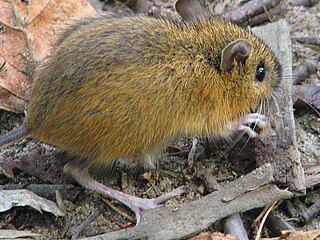
The woodland jumping mouse is a species of jumping mouse found in North America. It can jump up to 3 m (9.8 ft) using its extremely strong feet and long tail.
The Use of York or York Rite was a liturgical use of the Roman Rite – itself a Latin liturgical rite – practised in part of northern England, prior to the reign of Henry VIII. During Henry's reign the Use of York was suppressed in favour of the Use of Sarum, developed at Salisbury Cathedral, followed by the Book of Common Prayer. "Use" denotes the special liturgical customs which prevailed in a particular diocese or group of dioceses; it is one of the medieval English uses, together with the Use of Sarum, the Use of Hereford, and the Use of Bangor.

Nepenthes sibuyanensis is a tropical pitcher plant endemic to Sibuyan Island in the Philippines, after which it is named.
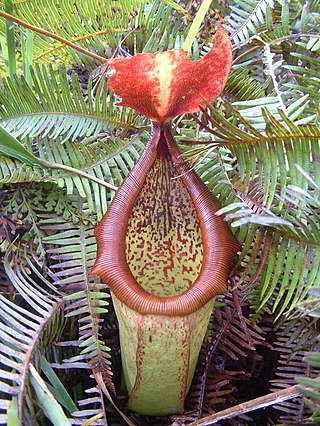
Nepenthes insignis is a tropical pitcher plant endemic to New Guinea and surrounding islands. The specific epithet insignis is Latin for "distinguished" or "remarkable".

Tetraceratops insignis is an extinct synapsid from the Early Permian that was formerly considered the earliest known representative of Therapsida, a group that includes mammals and their close extinct relatives. It is known from a single 90-millimetre-long (3.5 in) skull, discovered in Texas in 1908. According to a 2020 study, it should be classified as a primitive non-therapsid sphenacodont rather than a genuine basal therapsid.
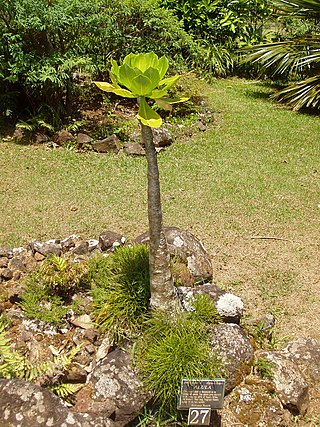
Brighamia insignis, commonly known as ʻŌlulu or Alula in Hawaiian, or colloquially as the vulcan palm or cabbage on a stick, is a species of Hawaiian lobelioid in the bellflower family, Campanulaceae. It is native to the islands of Kauaʻi and Niʻihau, but has been extinct in the wild since at least 2019-2020. This short-lived perennial species is a member of a unique endemic Hawaiian genus with only one other species.

The white-bellied heron also known as the imperial heron or great white-bellied heron, is a large heron species living in the foothills of the eastern Himalayas in northeast India and Bhutan to northern Myanmar. It inhabits undisturbed rivers and wetlands. It has been listed as Critically Endangered on the IUCN Red List since 2007, because the global population is estimated at less than 300 mature individuals and threatened by habitat loss and human disturbance. It is mostly dark grey with a white throat and underparts.

The Mindanao montane forest mouse is a species of rodent in the family Muridae. It is found only in the Philippines.
The montane African climbing mouse or remarkable climbing mouse is a species of rodent in the family Nesomyidae. It is found in Democratic Republic of the Congo, Kenya, Rwanda, Tanzania, and Uganda.

The white-rumped falcon is a species of bird of prey in the family Falconidae native to Indochina. It is placed in its own monotypic genus, Neohierax.

The orange-crowned fairywren is a species of passerine bird in the Australasian wren family, Maluridae. It is monotypic within the genus Clytomyias. It is found on New Guinea in its natural habitat of subtropical or tropical moist montane forests.

The brown-capped weaver is a species of bird in the family Ploceidae. It is found in Angola, Burundi, Cameroon, Republic of the Congo, Democratic Republic of the Congo, Equatorial Guinea, Kenya, Nigeria, Rwanda, South Sudan, Tanzania, and Uganda.
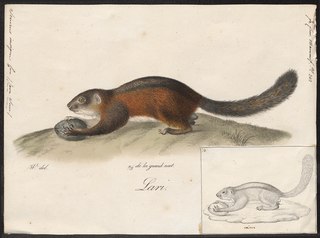
The three-striped ground squirrel is a species of rodent in the family Sciuridae. It is found in Indonesia, Malaysia, and Thailand.

The Cameroon scaly-tail, also referred to as the Cameroon anomalure, flightless anomalure or flightless scaly-tail, is a rodent species endemic to West Central Africa. The scientific literature has never reported observations of live individuals. The taxonomic classification of the species has been subject to recent revision.

Pachylemur is an extinct, giant lemur most closely related to the ruffed lemurs of genus Varecia. Two species are known, Pachylemur insignis and Pachylemur jullyi, although there is some doubt as to whether or not they may actually be the same species. Pachylemur is sometimes referred to as the giant ruffed lemur, because although it and the living ruffed lemurs had similar teeth and skeletons, Pachylemur was more robust and as much as three to four times larger. DNA studies have confirmed a sister group relationship between these two types of lemur. Like living ruffed lemurs, Pachylemur specialized in eating fruit, and was therefore an important seed disperser, possibly for tree species with seeds too large for even ruffed lemurs to swallow. In the spiny thickets of southwestern Madagascar, they were also likely to have dispersed seeds evolved to attach to fur and be carried away. Unlike ruffed lemurs, the fore- and hindlimbs of Pachylemur were nearly the same length, and therefore it was likely to be a slow, deliberate climber. However, both used hindlimb suspension to reach fruit on small branches below them.

Trimerorhachidae is a family of dvinosaurian temnospondyls, including Lafonius, Trimerorhachis, Procuhy and Neldasaurus.
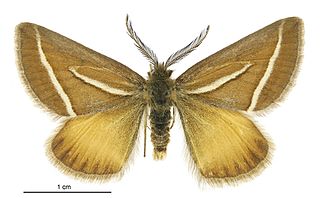
Aponotoreas insignis is a moth of the family Geometridae. It is endemic to New Zealand.

Nepenthes biak is a tropical pitcher plant endemic to the Indonesian island of Biak, after which it is named. Biak is a member of the Schouten Islands, located in Cenderawasih Bay, and is administered as part of Biak Numfor Regency, Papua Province. Nepenthes biak grows near sea level, usually on limestone coastal cliffs though occasionally as an epiphyte on mangrove trees.
















